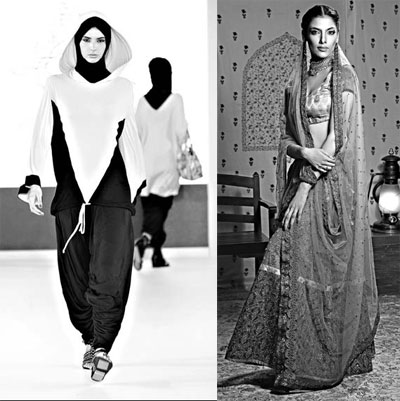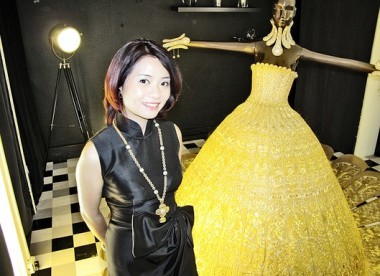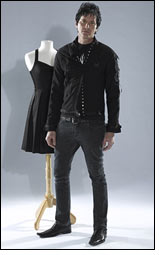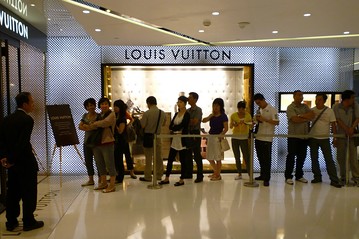 Mc kenneth Licon
Mc kenneth Licon IVANA J
IVANA J Izzy Bea
Izzy Bea Joana Gröblinghoff
Joana Gröblinghoff Luci Matheus
Luci Matheus
The 108th Canton Trade Fair will arrive on October 15, 2010, but many shoemakers have shown their low confidence to the upcoming trade fair, previously they tried their best to receive more orders on the trade fair, but right now they will be cautiously on signing the contracts because of RMB fluctuation. Many foreign trade shoe producers said their profits almost narrowed to zero as appreciation of yuan.
Applicants for this edition trade fair reduced to 98,000 from previous 115,000, according to the figure released by organizer.
This time we go to trade fair for meeting our old clients not for receiving more orders as we have enough for our production, the rising of yuan in September and materials price have offset our profits, said foreign trade director Ai Hanqiang in Zhuosen Footwear in Wenzhou. Many small scale enterprises in China like us face the same problem currently, Ai added.
An exhibition of creations of young Swedish designers will be held in Beijing 798 Art Zone from October, 12 to November, 7, which is organized by Swedish Institute.
These designers attracted fashion industry's attention at the beginning of 21st century. Their creations are more personalized and art oriented compared with those Swedish fashion representatives such as H&M and J. Lindeberg. What's more, these young designers share one common point namely their fashion career all begins in Sweden.
In order to present an all-around view of Swedish fashion industry, this exhibition not only contains designers' creations but also photos and texts to introduce the development of Swedish industry.

Women in India are opting for form-fitting business suits. In Sudan, a woman who dares to wear trousers is sent to jail. In the capitals of Europe, a Muslim head scarf becomes a political lightning rod. And across the Islamic world, new designers are nudging women to step out of fashion purdah with clothes that meld global catwalk trends with Muslim mores.
In old societies facing a flurry of Western goods and ideas, a woman often carries the competing demands of tradition and modernity on her back. How she dresses conveys a great deal more than her individual sense of style. She is evaluated by what she does or does not wear, whether it is by her parents, in-laws, co-workers, loutish men on the bus and even, as with the debate over the Islamic head scarf, by politicians.
Sometimes she conforms to tradition, sometimes she challenges it. Consider India today, where a decade of roaring economic growth has been accompanied by new opportunities for the urban, educated woman- and in turn, is offering her a vast menu of new looks.
"Almost every day I feel this country changes," said Anupama Dayal, a designer in New Delhi whose autumn collection features short dresses and floppy tunics. "And who changes the fastest? It's the woman."
As a woman earns more money, power and freedom, how she dresses often changes. But, more so than men, women find that their wardrobe choices are often calibrated by cultural expectations: modesty, authority, shifting ideals of femininity. What may connote tradition to a Westerner could telegraph a higher status to an Asian or African woman.
In Nigeria, for instance, a college student may wear skinny jeans or slinky dresses, but once she climbs the career ladder, a woman would rarely be seen in anything but customary Nigerian clothes, whose costliness and craft may be unclear to the Western eye.
Similarly in India, a young office worker today almost always wears trousers or suits. But a senior female manager would more likely choose a sari.
"I actually do think the sari makes me feel a lot more authoritative," said Ambika Nair, who has worked as a journalist and a lawyer and now runs the legal publishing arm of Thomson Reuters in India. "And I don't look at the sari or churidar as traditional, and I don't think wearing a suit, articularly an illfitting one, connotes modern."
The lives of Indian women are in a state of profound flux. Today, there are as many girls as boys enrolled in primary school. Women's share in the workplace has risen. Women increasingly live on their own, travel widely, adopt children as single mothers, and even divorce. All the while, they have to deal with entrenched social and religious customs, sexual harassment, and sometimes, outright violence.
In Indonesia, the world's most populous Muslim country, the hijab, or jilbab as it is known there, is far more common than it was a generation ago. But now, it could be a designer scarf held in place with an eclectic brooch, or paired with a trendy sun visor.
"We look to the West for style and trends, and we modify them to suit our modest needs," said Liana Rosnita Redwan-Beer, a magazine editor in Jakarta.
The balance is particularly tricky for Muslim women living in the West. Rabia Zagarpur was living in California when she began dressing according to Islamic code 10 years ago. "There's the dilemma that 'Oh my God, that's a cute trend but I can't wear it,'" she said of her own experience. "It's depressing to shop. And then of course there's work. Corporate wear? What do you wear?"
Ms. Zagarpur, now based in Dubai, began designing clothes for women like herself: track suits with longer, torso-covering tops, bold printed silk caftans, even a one-piece hoodie hijab made of stretchable, breathable fabric.
"To me," Ms. Zagarpur insists, "being modest and chic is very compatible."
Chic seems not to have been the concern of Lubna Hussein in Sudan when she was arrested last year on charges of indecency for wearing trousers, a crime punishable under Sudan's version of Sharia law by 40 lashes. The court eventually spared the whip but imposed a fine of about $200. When Ms. Hussein refused to pay, it sent her to jail.In India, where society is churning rapidly, women are required to make delicate choices all the time.
Suhasini Haidar, a TV anchor, wears a tailored blazer on air. But she knows that for an official government dinner, she must drape on a sari. "There are several places," she says, "where it would be rude to show up in Western clothes."
For Ms. Dayal, the sari is reserved for moments of reckoning. "When I most need my self-confidence, I must wear a sari," she says. "When I can take no risks, I must wear the sari - despite having Armanis and Guccis and hundreds of Anupamas in my wardrobe."

The Chinese presence at Paris Fashion Week, which is currently winding down, was perhaps greater than ever this year. In addition to Chinese celebrities like Fan Bingbing and Chen Ran making appearances at runway shows, we saw more China-inspired designs and materials making cameos. From Marc Jacobs incorporating silk and panda prints and Hong Kong’s Shiatzy Chen taking “Mao collars” to the catwalk to Guo Pei’s breathtaking gold thread dress, the growing Eastern influence in the fashion world was unmistakeable.
An interesting addition to this installment of Paris Fashion Week was the “China in Paris Showroom,” a three-day event that showcased the work of some of China’s up-and-coming designers. From Sohu (translation by Jing Daily team):
The “China in Paris contemporary creative Showroom,” which kicked off on October 1 in Paris, showed off China’s new creative power, including contemporary artwork, fashion, new series by creative designers, jewelry, and fashion photography. Some of the Chinese designers and artists who took part in the event included the founder and creative director of Shiatzy Chen, Wang Chen Cai-Xia, the famous Chinese contemporary artist Huang Zhiyang, Peng Wei, Chen Qingqing, and the Chinese clothing designer Guo Pei.
This installment of the “China in Paris Showroom” also included winners from last year’s fashion design contest, including Uma Wang (winner of the Youngor-Sunrise knit award), Masha Ma (winner of the Mouse Ji International creative award), Shi Jie (winner of the BASIC industry value award), and Le Lin, who won the FASHION GOU e-commerce award.
Not only did this event introduce the contemporary fashion stars who represent today’s Chinese fashion, it also provided a platform for Chinese designer brands to stand on the world stage. The Showroom proved a perfect spot to sell, and the main objective for the brands involved was to expand into the European and global markets while enhancing international market awareness of Chinese domestic brands. What really sets the Showroom apart from press conferences or exhibitions is that it’s a long-term platform for brands to hook up with international buyers and media, while laying the foundation for a brand’s international marketing efforts.
Indian leather exports grew 16.3% during the first five months of the current financial year (April-August). The country’s leather exports totalled to US$1.4 billion compared with US$1.2 billion during the corresponding period last year.
Leather footwear exports rose 16.7% to US$515.1 million from $441.4 million, while non-leather footwear exports grew 9.2% to $7.6 million from $6.9 million.
However, on a negative note, footwear component exports fell 1.9% to $98.8 million from $100.8 million.
Official figures show that Pakistan produced more leather in July than in July 2010. July production totalled 2.3 million square-metres compared with 1.8 million square-metres during the same month last year, a rise of 26.1%.
Footwear production increased to 3.8 million pairs from 2.7 million pairs, up 44.7% year-on-year.
Sole leather production posted an 81.3% increase to 29 tonnes compared with 16 tonnes in July 2009
 "Project Runway" winner Seth Aaron Henderson will stage a pioneering high-fashion runway collection inspired by solar technology at the very epicenter of U.S. solar power adoption – Southern California – in a showing as part of LA Fashion Week at the biggest solar-industry trade show in the Americas.
"Project Runway" winner Seth Aaron Henderson will stage a pioneering high-fashion runway collection inspired by solar technology at the very epicenter of U.S. solar power adoption – Southern California – in a showing as part of LA Fashion Week at the biggest solar-industry trade show in the Americas.
Models posing atop all-black SolarWorld Sunmodule solar panels will show off designs in the "Seth Aaron SolarWorld Collection Presented by Portland Fashion Week" at 1 p.m. Wednesday, Oct. 13, at the SolarWorld booth at Solar Power International, a photovoltaic technology trade show expected to attract more than 25,000 people. SolarWorld’s Booth 3708 is located in Los Angeles Convention Center’s South Hall H. LA Fashion Week runs from Oct. 13 to 20, Solar Power International from Oct. 12 to 14.
The solar-inspired runway collection will debut Oct. 9 at the sustainable fashion showcase Portland Fashion Week, featuring a runway composed of SolarWorld’s sleek black panels under the theme "Solar Is the New Black." The panels offer a homogeneous color variation for buyers interested an installing solar power technology with an aesthetic twist.
Seth Aaron, who plans to install solar on his own new home, is celebrating solar’s arrival by applying his edgy design vocabulary to what he believes to be the first non-literal, high-fashion interpretation of solar technology. He partnered with SolarWorld, the largest and most experienced U.S. manufacturer of crystalline silicon solar technology, and took inspiration from its production in Hillsboro, Ore., and Camarillo, Calif., a plant north of LA that has operated continuously since 1977. The facility has set many milestones in the solar development of California, by far the nation’s photovoltaic technology leader.
"What could be cooler?" says Seth Aaron, who won Season 7 of TV’s "Project Runway" competition last spring. "I get to feature my designs at key gatherings of two different crowds – enthusiasts of solar and fashion. It’s what I had in mind as I took on this project. Solar’s time is here, and in a way it’s like a lifestyle choice for a whole society … much like fashion is for the individual. I hope my fashion interpretation of the technology can serve as something of a two-industry celebration."

Throughout Hong Kong this week, shoppers have had to contend with large crowds, long lines and a curious plethora of suitcases being dragged through the streets.
It's Golden Week, which means an influx of mainland Chinese visitors to the city, many of whom spend their days shopping.
First implemented in 1999 by Beijing to promote domestic tourism, Golden Week occurs once in the spring, celebrating Lunar New Year, and once in the fall, surrounding the Oct. 1 National Day. The Hong Kong Tourism Board counted more than 600,000 mainland arrivals in the first six days of Golden Week – a 25% increase from the same period last year and the highest number in the past five years. Visitors don't go home empty-handed - last year, they spent an average of HK$7,000 during Golden Week.
Hong Kong's many malls are on most itineraries. The flagship Chanel, Gucci and Louis Vuitton stores on Canton Road in Tsim Sha Tsui drew 20-foot-long lines that were managed by notice signs, rope barriers and security doormen.
Shoppers are willing to wait. Hong Kong's lack of sales, luxury and import taxes, its wide product variety and the attractive RMB-to-HKD conversion rate make shopping a bargain. Luxury goods are often 30% cheaper than the same products in the mainland.
Many shoppers come equipped with large, empty suitcases, in which they stuff their purchases. Outside the Chanel store on Canton Road, a Ms. Chen and her family packed boxes of Ferragamo shoes into their already-full suitcases, before going home to Chengdu.
Hong Kong retailers are doing their part to capitalize on Golden Week by promoting special discounts and events. Stores specially produce signs in simplified Chinese (as opposed to traditional Chinese used in Hong Kong) for mainland customers.
Times Square, the popular Causeway Bay mall, saw a 7% growth in foot traffic this week from last year's Golden Week and expects a 20% increase in sales from last year. To lure mainland shoppers, the mall held a raffle, an iPad giveaway and a joint promotion with mainland bank card company China Union Pay. Wharf Holdings, which manages both Times Square and Harbour City, a shopping center in Tsim Sha Tsui, says approximately 20% of the malls' patrons come from mainland China. Since last year, the company has provided free shuttle buses from the port city of Shenzhen, in Guandong province, to the two malls.
Hong Kong, though, may soon have to fight for the honor of being China's top shopping destination. Duty-free shopping zones are being set up on tropical Hainan island that could offer similar prices and, perhaps, shorter lines.
During the festivals of Mid-Autumn and National Day sales for travelling luggage and bags met a dramatic surging in almost all the markets national wide, for instance luggage sales in department stores in Changsha city reached ten thousand pieces per day from September 30 to October 5.
The head of luggage and bags sector in Apollo Commercial Square in Changsha city said our sale revenue saw a double growth during the seven holidays to 550,000 yuan compared with the same period of last year. Package and trolley luggage were the most favorable products sold well these days.
The responsible person of taboo.com, the largest retail website in China, said each day we sold 9000 pieces of luggage during the holiday that is more than two times than the sales in previous year. the best seller was the backpack
The delegation of International Textile and Apparel Association (ITAA) paid a visit to China Textile City Hangzhou Ruifang Union Market, yesterday. This delegation included almost 30 members of the board of ITAA from USA, Britain, Spain and Holland and so on.
ITAA is the world-leading textile and apparel organization which provides service to global entrepreneurs and managers of textile and apparel enterprises. It collects and shares information related to apparel design, production, sale, purchase, trade and technology.
China Textile City is a member of this organization. A few days ago, the annual conference of ITAA was held in Hong Kong. Later the delegation of ITAA was invited to visit Hangzhou. The delegation members were expected to find business opportunities in Hangzhou.
According to one member of this delegation, Mr. Frans Baviera, he gained a lot after the visit. Mr. Frans Baviera was also the principal of Span textile council. He was very interested in the one-stop purchasing mode of Hangzhou Ruifang Union Market. What's more, he was expected to establish a purchasing office here.